Microbubbles as Proxies for Oil Spill Delineation in Field Tests
Abstract
:1. Introduction
2. Sonar Applications for Oil and Gas Detection
2.1. Previous Work
2.2. Proof-of-Concept Sonar Experiment
- An oil plume can potentially be pre-detected by an AUV prior to entering the plume.
- Sonar fan-shaped image display is more suitable than point-based oil sensors for discontinuous oil patches to make an adaptive decision on the next waypoints or trajectory to delineate the plume.
- The two-dimensional survey of the scanning sonar has advantages over a point-based survey to undertake an adaptive mission for a dynamically dispersing target such as an oil plume.
3. Experiment Setup
3.1. Bubble Gennerator
3.2. Sensor Suite
4. Experiment and Results
4.1. Experimental Setup
4.2. Measurements from the Experiment
4.2.1. Bubble Size Distribution
- A higher proportion of smaller bubbles was found at deeper positions. For example, at position F which was at a depth of 1.5 m, more than 90% of the bubbles were smaller than 100 microns, while at position E which was at the depth of 1.0 m, the majority were within the range of 100–150 microns. At a shallower position (position D), more large bubbles between 200 and 250 microns were found. The difference in size distribution at varied depths was owing to the rise velocities of differently sized bubbles. Large bubbles rose quickly toward the water surface while small bubbles rose more slowly leading to a larger proportion of small bubbles staying at depth.
- A larger percentage of smaller bubbles were collected at the farthest distance from the release nozzle. For example, at the water depth of 1.5 m, only 80% of bubbles found at position A were smaller than 100 microns while almost all the bubble (99%) found at position G were smaller than 100 microns. For position C, D, and I, a larger proportion of bubbles with sizes smaller than 250 microns were collected at position I, the longest distance from the release nozzle among the 3 positions placed at 0.5 m water depth.
4.2.2. Residence Time of Bubbles
- The residence time decreased with an increase in water depth. One can expect bubbles to rise up from deeper to shallower water. Therefore, the residence time measured at a shallower position, e.g., position 3, can be considered to be the length of time from the first bubbles appeared in this shallow water region when the bubble generator was stopped until the time when the last bubble that rose from the deeper water to this region disappeared.
- In most cases, the residence time of bubbles increased with the distance from the release nozzle. This was because the release nozzle had an inclination angle which drove the bubbles deeper away from the nozzle. There was an exception at the depth of 0.5 m where the residence times of bubbles at position 3, 4, and 9 were 304 s, 364 s, and 323 s respectively. For position 9, the residence time of the bubbles was shorter than that collected at position 4. Considering position 9 to be the furthest point from the center of the plume, this phenomenon was possibly caused by bubbles disappearing due to shrinking or dissolution of the gas as they rose through the water column toward the surface. Besides, at a longer distance from the nozzle, the low density of bubbles at shallower depth also affected the images collected by the sonar, which affects the calculation of residence time at the end. Moreover, the residence times obtained at these positions may have been affected by the bubbles that rose up from positions directly underneath them (position A, F, and G, respectively). As position F had a higher percentage of bubbles below the size of 50 microns compared with position A and G, these bubbles may have risen up slowly to the depth of 0.5 m, contributing to longer residence time collected at position 4. This was also witnessed at position A and G. Position G has a higher percentage of small bubbles within the size range of 50–100 microns than position A, which probably resulted in the residence time collected at position 9 being longer than that at position 3.
5. Discussion
6. Conclusions
- A Nikuni KTM pump was able to generate bubbles with sizes less than 100 microns.
- A Ping360 sonar with a frequency of 750 kHz was found to have the ability to detect microbubble plumes which contain bubbles with sizes less than 100 microns.
- Smaller bubbles were found at a higher percentage of the total numbers of bubbles in deeper water, such as at the depth of 1.5 m, as large bubbles having higher rise velocities surfaced quickly without staying in the water column.
- The residence time of the bubble plumes at the depth of 0.5 m was estimated to be over 5 min. The bubbles were generated by the Nikuni KTM pump and released in less than 2 m of water at a depth of 1 m and an inclination angle of 20°.
Author Contributions
Funding
Institutional Review Board Statement
Informed Consent Statement
Data Availability Statement
Conflicts of Interest
References
- Saadoun, I.M.K. Impact of Oil Spills on Marine Life. In Emerging Pollutants in the Environment-Current and Further Implications; InTech: Lonon, UK, 2015; pp. 75–104. [Google Scholar]
- Socolofsky, S.A.; Adams, E.E.; Sherwood, C.R. Formation dynamics of subsurface hydrocarbon intrusions following the Deepwater Horizon blowout. Geophys. Res. Lett. 2011, 38, 1–6. [Google Scholar] [CrossRef] [Green Version]
- North, E.W.; Adams, E.E.; Thessen, A.E.; Schlag, Z.; He, R.; Socolofsky, S.A.; Masutani, S.M.; Peckham, S.D. The influence of droplet size and biodegradation on the transport of subsurface oil droplets during the Deepwater Horizon spill: A model sensitivity study. Environ. Res. Lett. 2015, 10, 1–12. [Google Scholar] [CrossRef]
- Chan, G.K.Y.; Chow, A.C.; Adams, E.E. Effects of droplet size on intrusion of sub-surface oil spills. Environ. Fluid Mech. 2015, 15, 959–973. [Google Scholar] [CrossRef] [Green Version]
- Conmy, R.N.; Coble, P.G.; Farr, J.; Wood, A.M.; Lee, K.; Pegau, W.S.; Walsh, I.D.; Koch, C.R.; Abercrombie, M.I.; Miles, M.S.; et al. Submersible optical sensors exposed to chemically dispersed crude oil: Wave tank simulations for improved oil spill monitoring. Environ. Sci. Technol. 2014, 48, 1803–1810. [Google Scholar] [CrossRef] [PubMed]
- Pang, S.; Farrell, J.A. Chemical plume source localization. IEEE Trans. Syst. Man Cybern. Part B Cybern. 2006, 36, 1068–1080. [Google Scholar] [CrossRef]
- Hwang, J.; Bose, N.; Fan, S.; Robinson, B.; Tenekedjiev, K. Complications of robotic delineation of oil spills at sea. In Proceedings of the 20th Commemorative Annual General Assembly, AGA 2019-Proceedings of the International Association of Maritime Universities Conference, IAMUC 2019, Tokyo, Japan, 30 October–1 November 2019; pp. 26–33. [Google Scholar]
- Hwang, J.; Bose, N.; Robinson, B.; Nguyen, H. Assessing hydrocarbon presence in the waters of port au port bay, newfoundland and labrador, for auv oil spill delineation tests. J. Ocean Technol. 2020, 15, 100–112. [Google Scholar]
- Eriksen, P.K. Leakage and oil spill detection utilizing active acoustic systems. In Proceedings of the 2013 IEEE International Underwater Technology Symposium, Tokyo, Japan, 5–8 March 2013; pp. 1–8. [Google Scholar]
- López-Castejón, F.; Gilabert, J. (Eds.) Underwater Robotics ready for Oil Spill; Technical Paper URready4OS Project; URready4OS: Cartagena, Spain, 2019; Volume 2, pp. 1–98. [Google Scholar]
- Battelle. Capabilities and Uses of Sensor-Equipped Ocean Vehicles for Subsea and Surface Detection and Tracking of Oil Spills; Battelle: Columbus, OH, USA, 2014. [Google Scholar]
- Pärt, S.; Kõuts, T. In-Situ Oil Detection Sensor–Technology Overview and Experiment Design WP1: Oil Spill Detection, Monitoring, Fate and Distribution; Tallinn University of Technology: Tallinn, Estonia, 2016. [Google Scholar]
- Tsuge, H. Micro- and Nanobubbles: Fundamentals and Applications; Tsuge, H., Ed.; Jenny Stanford Publishing: Singapore, 2014; ISBN 9789814463119. [Google Scholar]
- Tamura, I.; Adachi, K. Developing a micro-bubble generator and practical system for purifying contaminated water. Stud. Sci. Technol. 2014, 3, 87–90. [Google Scholar] [CrossRef]
- Khuntia, S.; Majumder, S.K.; Ghosh, P. Microbubble-aided water and wastewater purification: A review. Rev. Chem. Eng. 2012, 28, 191–221. [Google Scholar] [CrossRef]
- Panetta, P.D.; Bland, L.G.; Cartwright, G.; Friedrichs, C.T. Acoustic scattering to measure dispersed oil droplet size and sediment particle size. In Proceedings of the OCEANS 2012 MTS/IEEE: Harnessing the Power of the Ocean, Hampton Roads, VA, USA, 14–19 October 2012; pp. 1–9. [Google Scholar]
- Maksym, T.; Singh, H.; Bassett, C.; Lavery, A.; Freitag, L.; Sonnichsen, F. Oil Spill Detection and Mapping under Arctic Sea Ice Using Autonomous Underwater Vehicles; Bureau of Safety and Environmental Enforcement: New Orleans, LA, USA, 2014.
- Wen, R.; Sinding-Larsen, R. Mapping oil seeps on the sea floor by gloria side-scan sonar images-A case study from the Northern Gulf of Mexico. Nat. Resour. Res. 1996, 5, 141–154. [Google Scholar] [CrossRef]
- Wendelboe, G.; Fonseca, L.; Eriksen, M.; Hvidbak, F.; Mutschler, M. Detection of heavy oil on the seabed by application of a 400 kHz multibeam echo sounder. In Proceedings of the 32nd AMOP Technical Seminar on Environmental Contamination and Response, Ottawa, ON, Canada, 9–11 June 2009; Volume 2, pp. 791–816. [Google Scholar]
- Parthiot, F.; de Nanteuil, E.; Merlin, F.; Zerr, B.; Guedes, Y.; Lurton, X.; Augustin, J.-M.; Cervenka, P.; Marchal, J.; Sessarego, J.P.; et al. Sonar detection and monitoring of sunken heavy fuel oil on the seafloor. In Proceedings of the Interspill, Trondheim, Norway, 14–17 June 2004; pp. 1–13. [Google Scholar]
- Bello, J.; Eriksen, P.; Pocwiardowski, P. Oil Leak Detections with a Combined Telescopic Fluorescence Sensor and a Wide Band MultiBeam Sonar. Int. Oil Spill Conf. Proc. 2017, 2017, 1559–1573. [Google Scholar] [CrossRef]
- Clarke, J.E.H. Gas Plumes Analysis Using Multibeam EM710 Water Column Image in Saint John River Hesham Elhegazy; University of New Brunswick: Brunswick, NB, Canada, 2011. [Google Scholar]
- Camilli, R.; Di Iorio, D.; Bowen, A.; Reddy, C.M.; Techet, A.H.; Yoerger, D.R.; Whitcomb, L.L.; Seewald, J.S.; Sylva, S.P.; Fenwick, J. Acoustic measurement of the Deepwater Horizon Macondo well flow rate. Proc. Natl. Acad. Sci. USA 2012, 109, 20235–20239. [Google Scholar] [CrossRef] [PubMed] [Green Version]
- Fitzpatrick, M.; Balsley, A.; Hansen, K.A. Detection of Oil in Water Column, Final Report: Detection Prototype Tests; U.S. Department of Homeland Security: Washington, DC, USA, 2014.
- Baszanowska, E.; Otremba, Z. Fluorometry in application to fingerprint of petroleum products present in the natural waters. J. Eur. Opt. Soc. 2016, 12, 1–9. [Google Scholar] [CrossRef] [Green Version]
- Bello, J.M.; Eriksen, P.; Pocwiardowski, P. Report to BSEE: Oil Leak Detections with a Combined Fluorescence Polarization Instrument and a Wide Band MultiBeam Sonar Phase II Final Report Work Performed Under Contract E14PC00033 Bureau of Safety and Environmental Enforcement (BSEE) Oil Spill Response Research Branch; Bureau of Safety and Environmental Enforcement: New Orleans, LA, USA, 2016.
- Wilkinson, J.; Maksym, T.; Singh, H. Capabilities for Detection of Oil Spills under Sea Ice from Autonomous Underwater Vehicles; The International Association of Oil & Gas Producers (IOGP): London, UK, 2013. [Google Scholar]
- Loranger, S.C. Acoustic Detection and Quantification of Crude Oil; University of New Hampshire: Durham, NH, USA, 2019. [Google Scholar]
- Fitzpatrick, M.; Tebeau, P.A. Detection of Oil in Water Column: Sensor Design; U.S. Department of Homeland Security: Washington, DC, USA, 2013.
- Scandella, B.; Urban, P.; Delwiche, K.; Greinert, J.; Hemond, H.; Ruppel, C.D.; Juanes, R.; Scandella, B.; Urban, P.; Delwiche, K.; et al. Quantifying methane flux from lake sediments using multibeam sonar. In Proceedings of the American Geophysical Union Fall Meeting, San Francisco, CA, USA, 9–13 December 2013. Abstract id: B53B-0456. [Google Scholar]
- Veloso, M.; Greinert, J.; Mienert, J.; De Batist, M. A new methodology for quantifying bubble flow rates in deep water using splitbeam echosounders: Examples from the Arctic offshore NW-Svalbard. Limnol. Oceanogr. Methods 2015, 13, 267–287. [Google Scholar] [CrossRef] [Green Version]
- Leifer, I.; Chernykh, D.; Shakhova, N.; Semiletov, I. Sonar gas flux estimation by bubble insonification: Application to methane bubble flux from seep areas in the outer Laptev Sea. Cryosphere 2017, 11, 1333–1350. [Google Scholar] [CrossRef] [Green Version]
- Uchimoto, K.; Nishimura, M.; Xue, Z.; Watanabe, Y. A preliminary experiment on the detection of bubbles in the sea with side-scan sonar. In Proceedings of the 14th Greenhouse Gas Control Technologies Conference, 14th Greenhouse Gas Control Technologies Conference, Melbourne, Australia, 21–26 October 2018; pp. 1–9. [Google Scholar]
- Von Deimling, J.S.; Greinert, J.; Chapman, N.R.; Rabbel, W.; Linke, P. Acoustic imaging of natural gas seepage in the North Sea: Sensing bubbles controlled by variable currents. Limnol. Oceanogr. Methods 2010, 8, 155–171. [Google Scholar] [CrossRef]
- Klaucke, I.; Sahling, H.; Bürk, D.; Weinrebe, W.; Bohrmann, G. Mapping deep-water gas emissions with sidescan sonar. Eos Trans. Am. Geophys. Union 2005, 86, 341–346. [Google Scholar] [CrossRef] [Green Version]
- Crone, T.J.; Tolstoy, M. Magnitude of the 2010 Gulf of Mexico oil leak. Science 2010, 330, 634. [Google Scholar] [CrossRef] [Green Version]
- Weber, T.C.; De Robertis, A.; Greenaway, S.F.; Smith, S.; Mayer, L.; Rice, G. Estimating oil concentration and flow rate with calibrated vessel-mounted acoustic echo sounders. Proc. Natl. Acad. Sci. USA 2012, 109, 20240–20245. [Google Scholar] [CrossRef] [Green Version]
- David, L.; Mudge, T. Acoustic Detection of Subsurface Oil; ASL Environmental Sciences: Victoria, BC, Canada, 2018. [Google Scholar]
- Szczucka, J. Acoustic Detection of Gas Bubbles in the Sea. Oceanologia 1989, 28, 103–113. [Google Scholar]
- Johansen, Ø.; Rye, H.; Cooper, C. DeepSpill-Field study of a simulated oil and gas blowout in deep water. Spill Sci. Technol. Bull. 2003, 8, 433–443. [Google Scholar] [CrossRef]
- Balsley, A.; Hansen, K.; Fitzpatrick, M. Detection of oil within the water column. In Proceedings of the International Oil Spill Conference, Savannah, GA, USA, 5–8 May 2014; pp. 2206–2217. [Google Scholar]
- Blomberg, A.E.A.; Sæbø, T.O.; Hansen, R.E.; Pedersen, R.B.; Austeng, A. Automatic Detection of Marine Gas Seeps Using an Interferometric Sidescan Sonar. IEEE J. Ocean. Eng. 2017, 42, 590–602. [Google Scholar] [CrossRef]
- Hwang, J.; Bose, N.; Nguyen, H.D.; Williams, G. Acoustic search and detection of oil plumes using an autonomous underwater vehicle. J. Mar. Sci. Eng. 2020, 8, 618. [Google Scholar] [CrossRef]
- Zedel, L.; Butt, S. Using micro-bubbles as acoustic targets for large scale fluid flow experiments. In Proceedings of the 2011 IEEE/OES/CWTM 10th Working Conference on Current, Waves and Turbulence Measurement, CWTM, Monterey, CA, USA, 20–23 March 2011; pp. 224–229. [Google Scholar]
- Etchepare, R.; Oliveira, H.; Nicknig, M.; Azevedo, A.; Rubio, J. Nanobubbles: Generation using a multiphase pump, properties and features in flotation. Miner. Eng. 2017, 112, 19–26. [Google Scholar] [CrossRef]
- Aeration & Mixing Ltd. Nikuni KTM Gas-Mixing Fine Bubble Generating Pumps. Available online: https://www.aerationmixing.co.uk/products/nikuni-ktm-gas-mixing-fine-bubble-generating-aerator-pumps/ (accessed on 27 October 2020).
- BlueROV2-Affordable and Capable Underwater ROV. Available online: https://bluerobotics.com/store/rov/bluerov2/ (accessed on 1 March 2020).
- Sequoia Scientific. LISST-200X Particle Size Analyzer User’s Manual; Sequoia Scientific, Inc.: Bellevue, WA, USA, 2020. [Google Scholar]
- BlueRobotics Ping360 Scanning Imaging Sonar for ROVs. Available online: https://bluerobotics.com/store/sensors-sonars-cameras/sonar/ping360-sonar-r1-rp/ (accessed on 27 October 2020).
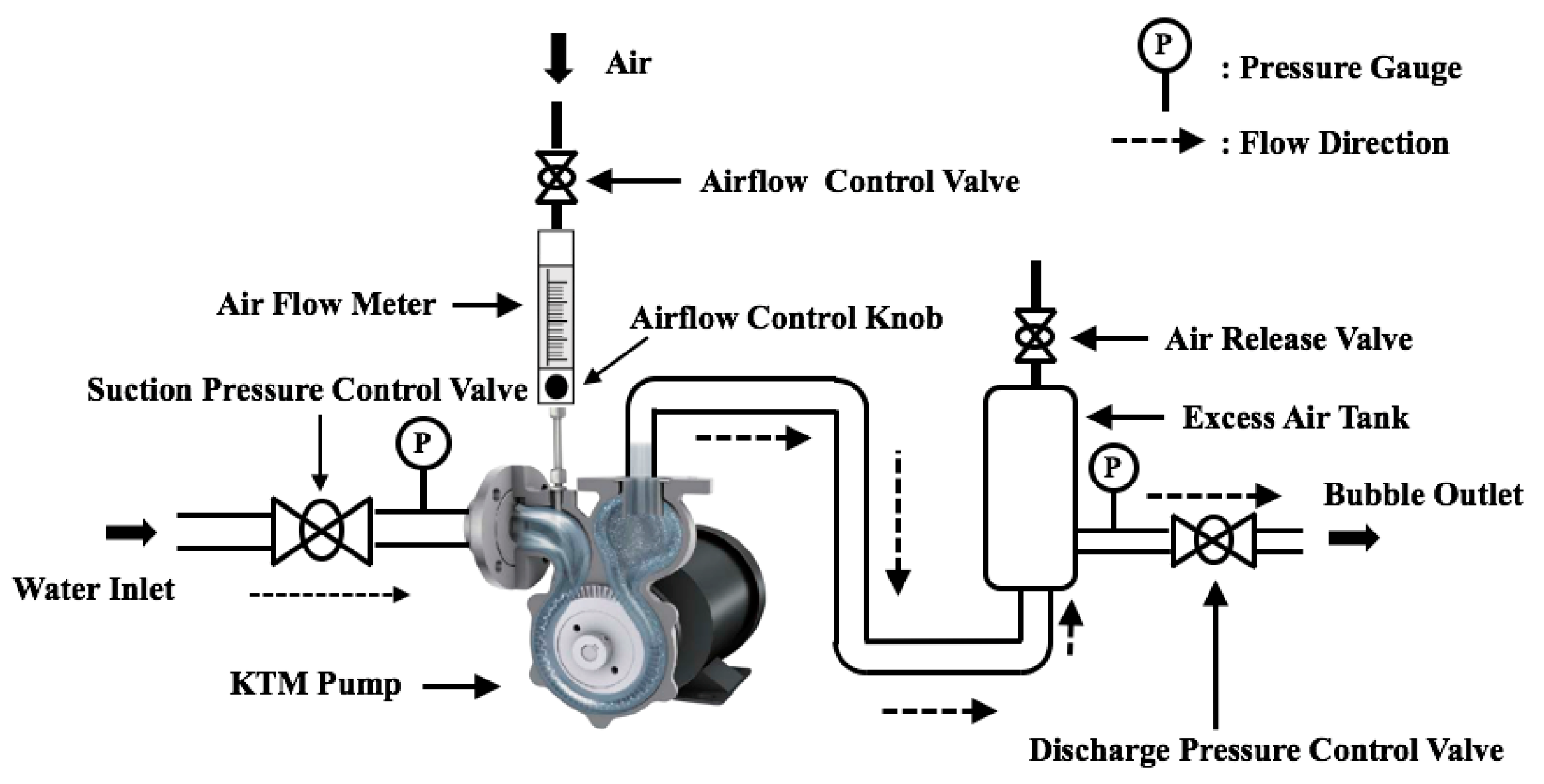

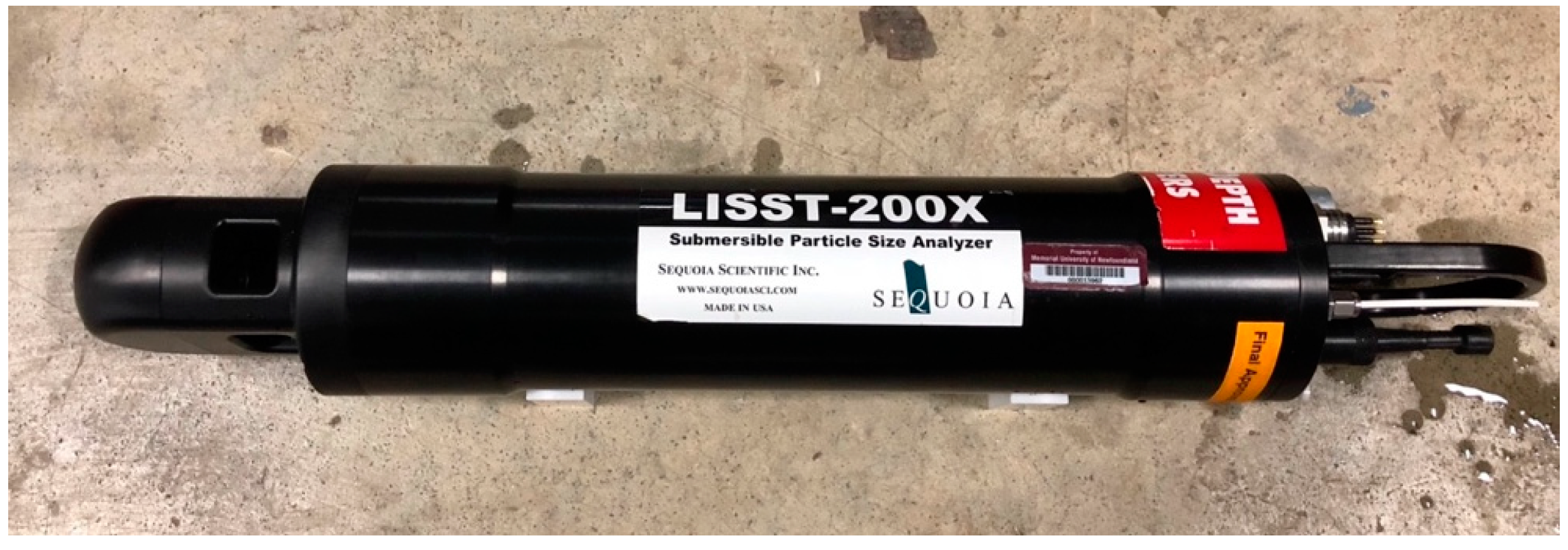
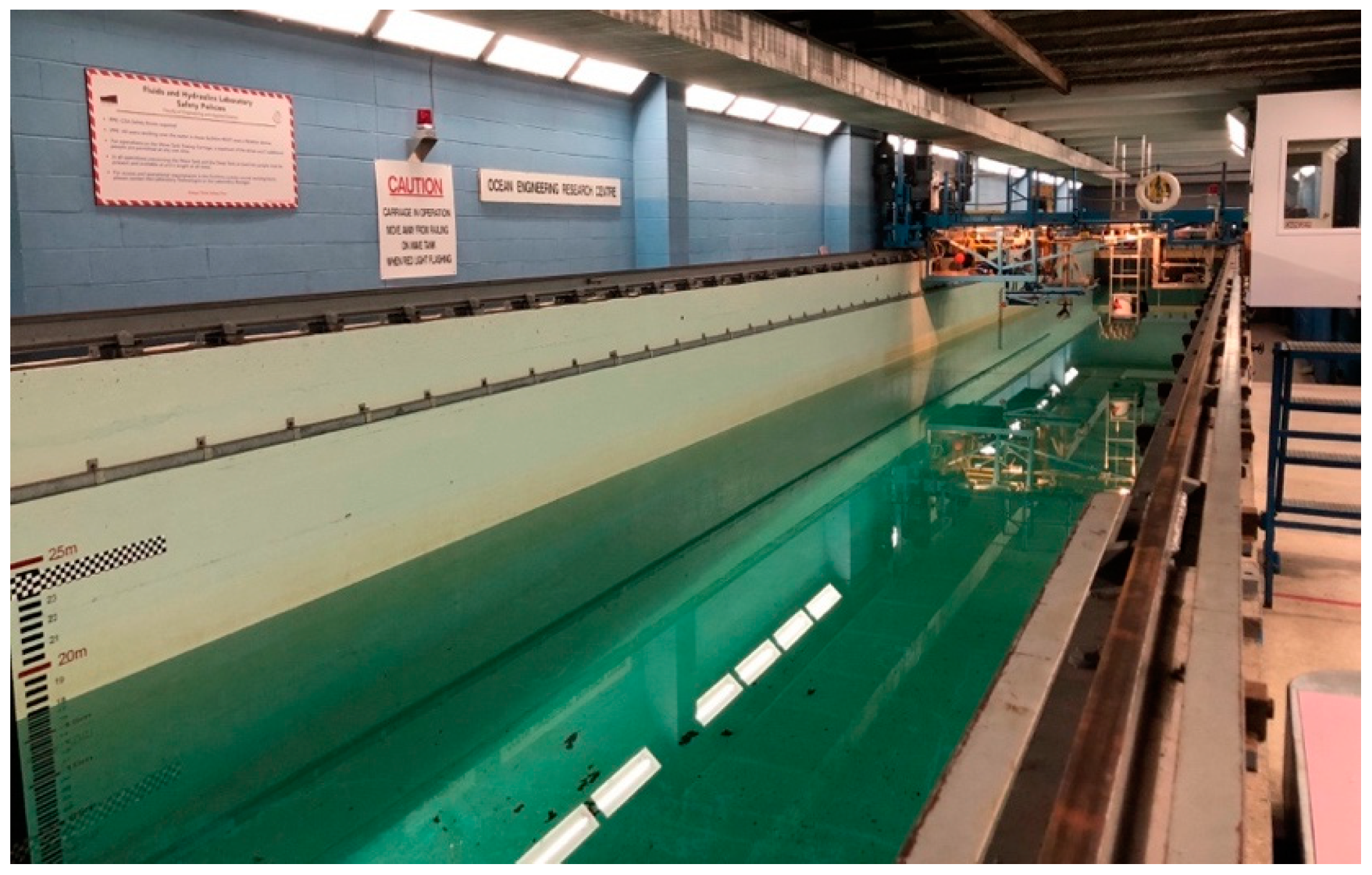
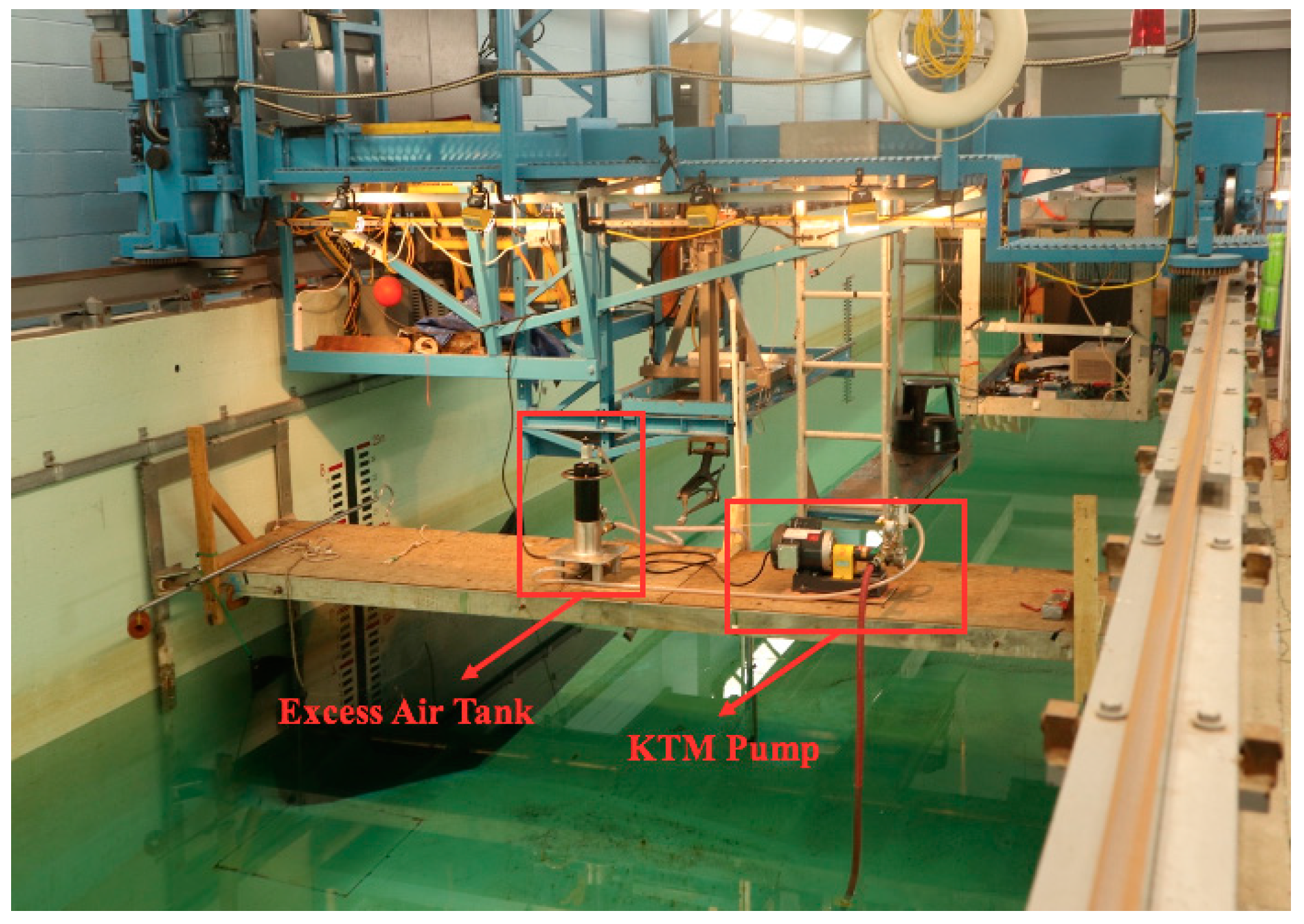
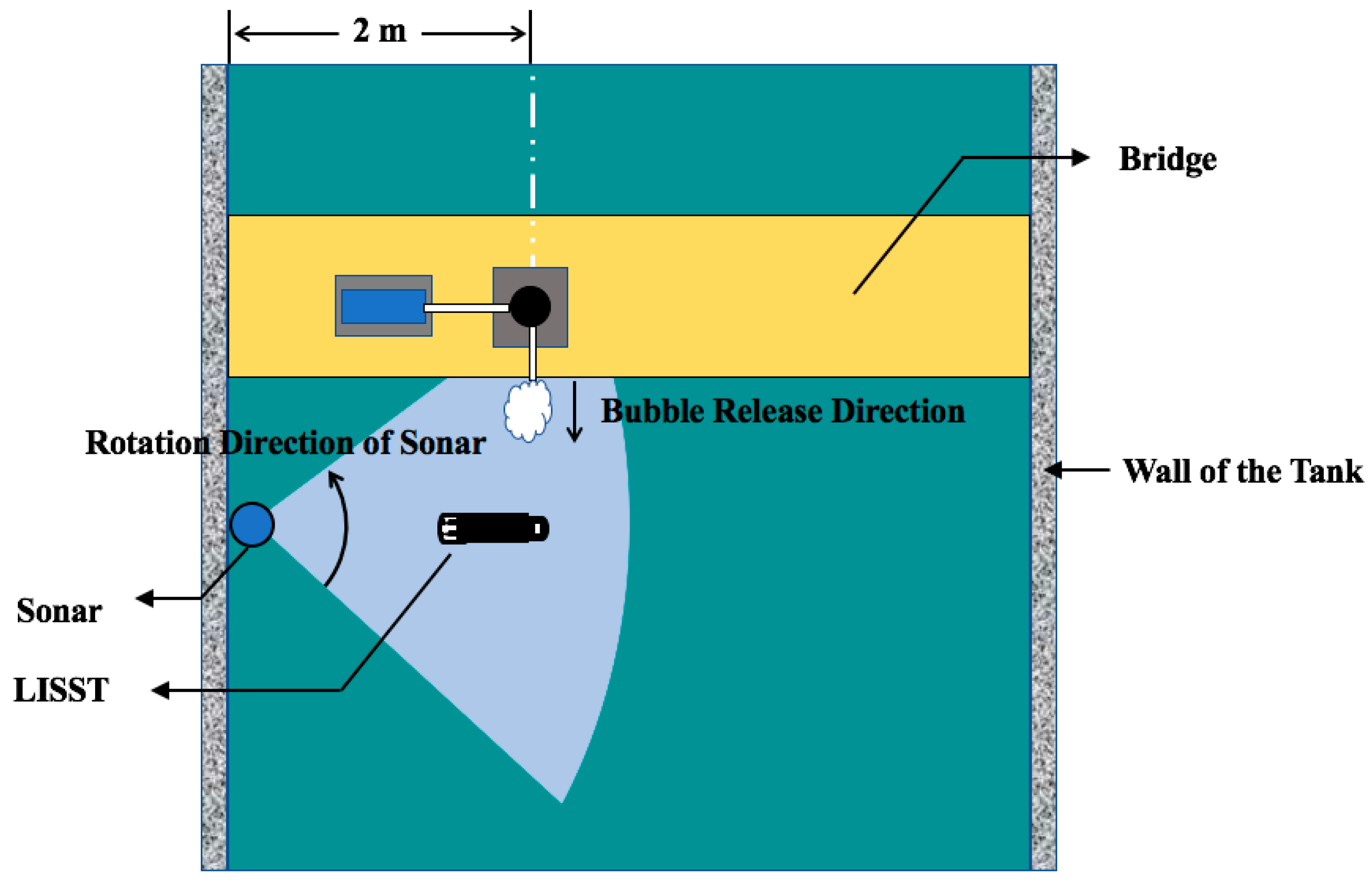
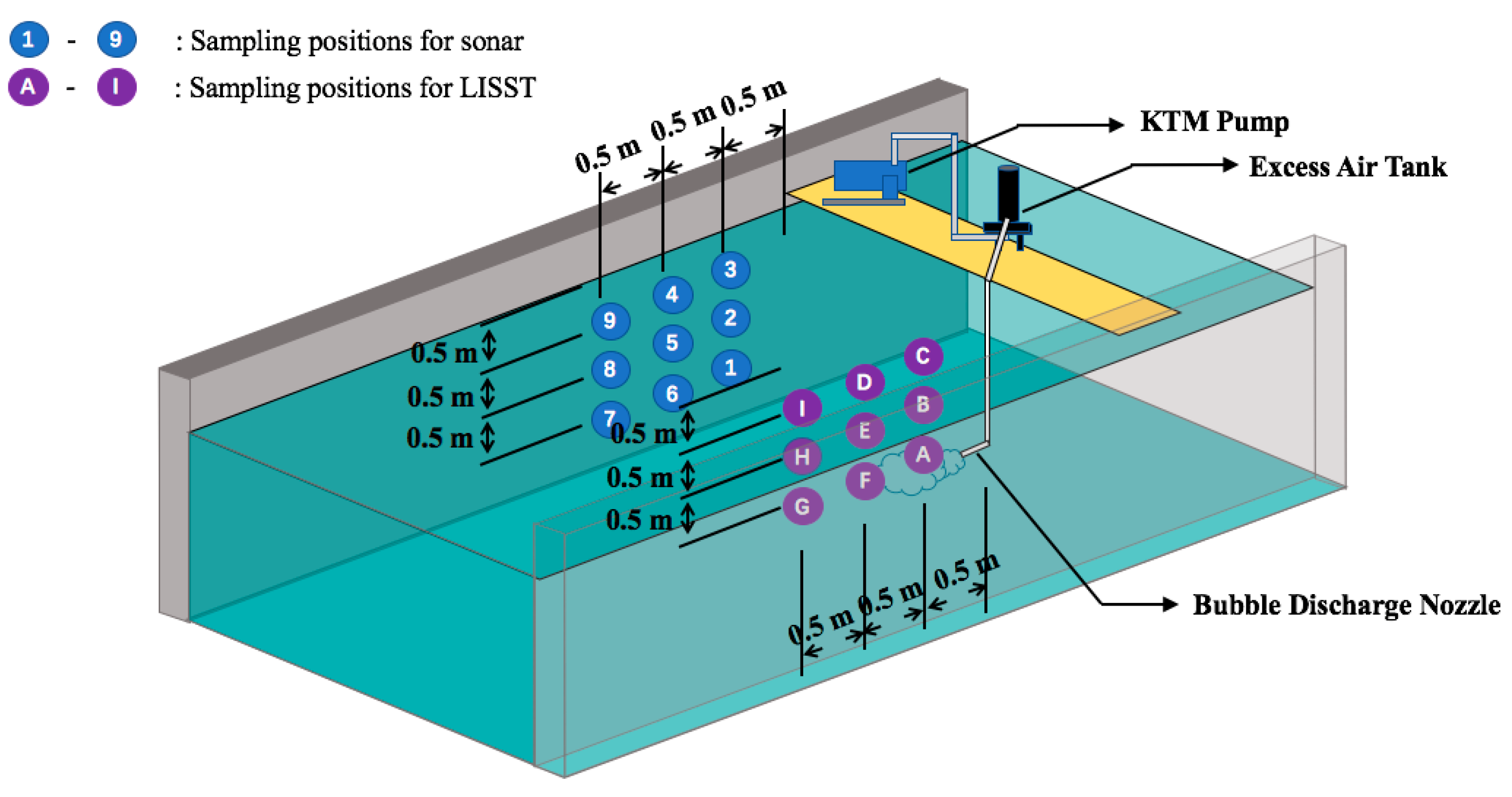
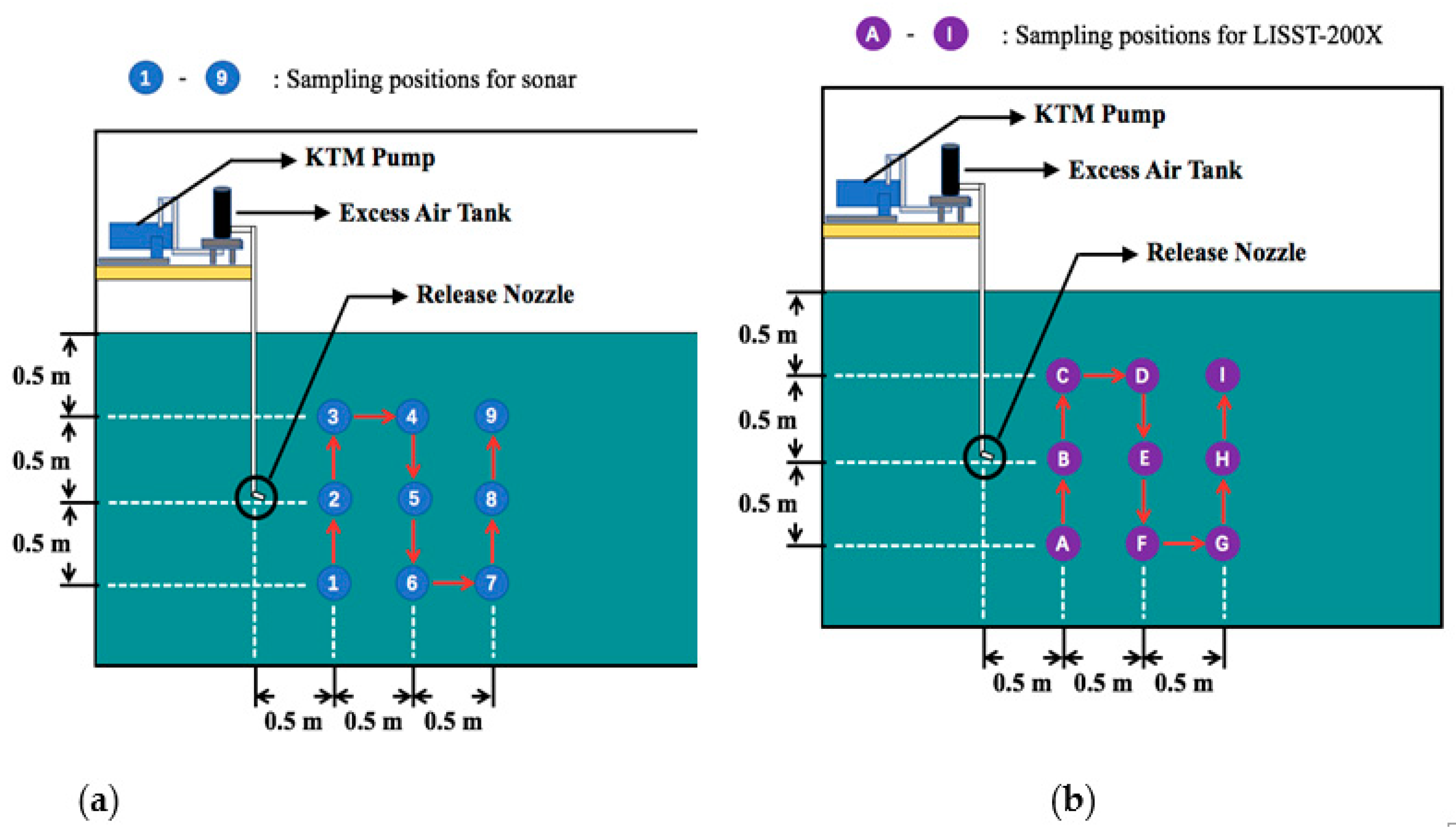


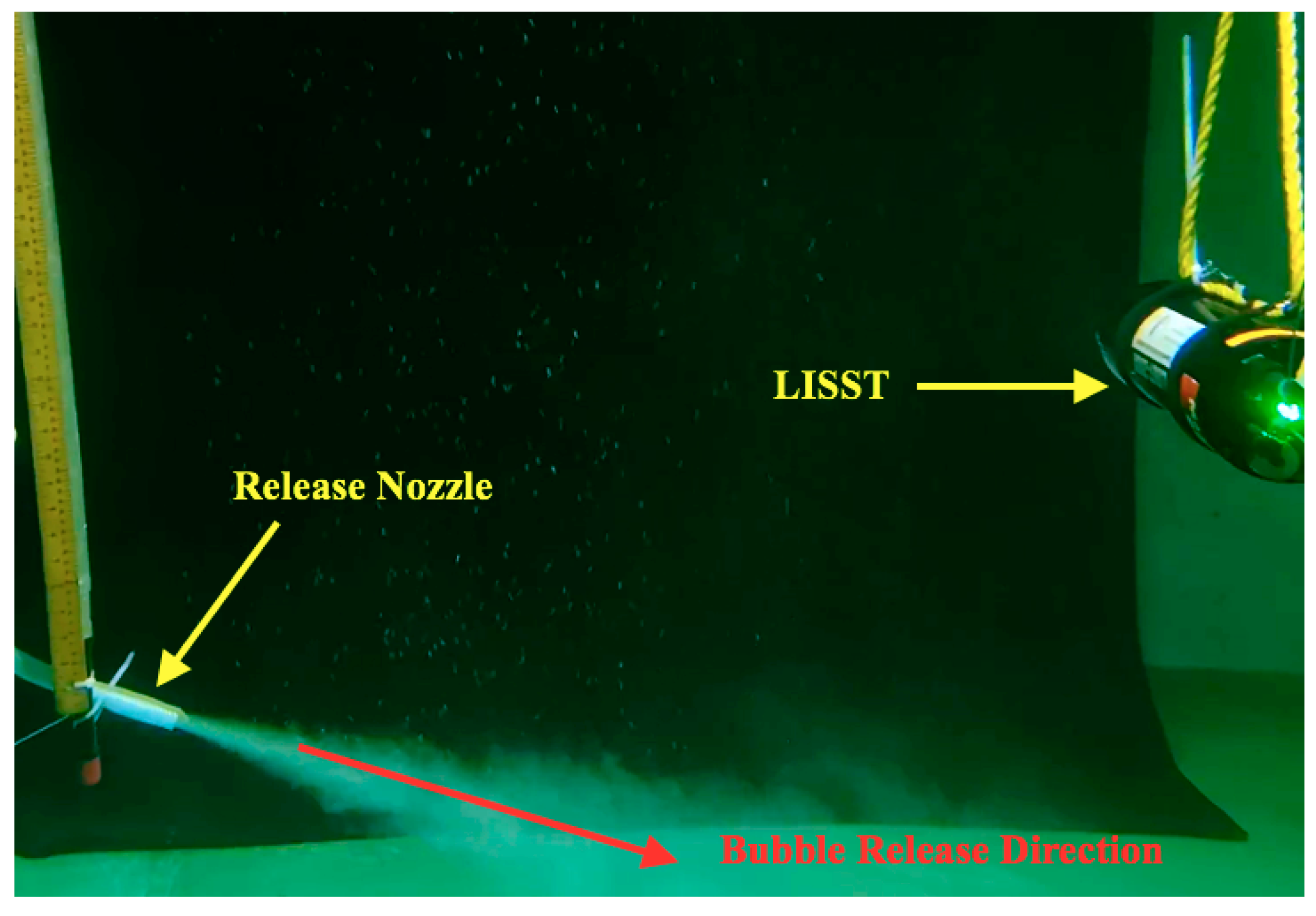



| Parameter | Value |
|---|---|
| Frequency | 750 kHz |
| Supply Voltage | 11–25 volts |
| Beamwidth (Horizontal) | 2° |
| Beamwidth (Vertical) | 25° |
| Working Range | 0.75–50 m |
| Weight in Air | 510 g |
| Scan Speed at 2 m | 9 s/360° |
| Scan Speed at 50 m | 35 s/360° |
| Range Resolution | 0.08% of the range |
| Test No. | Position of Sonar | Position of LISST-200X |
|---|---|---|
| 1 | 1 | A |
| 2 | 2 | B |
| 3 | 3 | C |
| 4 | 4 | D |
| 5 | 5 | E |
| 6 | 6 | F |
| 7 | 7 | G |
| 8 | 8 | H |
| 9 | 9 | I |
| Distance *: 0.5 m | Distance: 1.0 m | Distance: 1.5 m | ||||
|---|---|---|---|---|---|---|
| Depth: 0.5 m | Position 3: | Position 4: | Position 9: | |||
| 304 s | 364 s | 323 s | ||||
| Depth: 1.0 m | Position 2: | Position 5: | Position 8: | |||
| 106 s | 148 s | 214 s | ||||
| Depth: 1.5 m | Position 1: | Position 6: | Position 7: | |||
| 65 s | 77 s | 133 s | ||||
Publisher’s Note: MDPI stays neutral with regard to jurisdictional claims in published maps and institutional affiliations. |
© 2021 by the authors. Licensee MDPI, Basel, Switzerland. This article is an open access article distributed under the terms and conditions of the Creative Commons Attribution (CC BY) license (http://creativecommons.org/licenses/by/4.0/).
Share and Cite
Wang, Y.; Thanyamanta, W.; Bulger, C.; Bose, N.; Hwang, J. Microbubbles as Proxies for Oil Spill Delineation in Field Tests. J. Mar. Sci. Eng. 2021, 9, 126. https://doi.org/10.3390/jmse9020126
Wang Y, Thanyamanta W, Bulger C, Bose N, Hwang J. Microbubbles as Proxies for Oil Spill Delineation in Field Tests. Journal of Marine Science and Engineering. 2021; 9(2):126. https://doi.org/10.3390/jmse9020126
Chicago/Turabian StyleWang, Yaomei, Worakanok Thanyamanta, Craig Bulger, Neil Bose, and Jimin Hwang. 2021. "Microbubbles as Proxies for Oil Spill Delineation in Field Tests" Journal of Marine Science and Engineering 9, no. 2: 126. https://doi.org/10.3390/jmse9020126
APA StyleWang, Y., Thanyamanta, W., Bulger, C., Bose, N., & Hwang, J. (2021). Microbubbles as Proxies for Oil Spill Delineation in Field Tests. Journal of Marine Science and Engineering, 9(2), 126. https://doi.org/10.3390/jmse9020126








